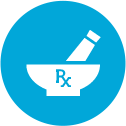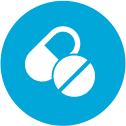Over 90% of your patients would prefer to get their medications at the point of care.
Reasons include:

Convenience
No additional or multiple trips to the pharmacy or delays caused by prior authorization or pharmacy physician interactions

Compliance
Compliance rates are 60-70% higher than prescriptions from a retail pharmacy, reducing long term care costs hundreds of dollars for each $1 invested in compliance

Cost
Welgo lets the physician bill at cash or at pharmacy benefit or PBM reimbursement – at no additional cost to the patient than the patient would pay at a pharmacy under his or her pharmacy benefit – there is no difference for insured patients; for uninsured patients, medications are generally the same or lower than retail pharmacy prices

Care
Payers and other healthcare constituencies benefit from improved medication compliance and adherence. Physicians know that his or her patients receive their needed medications resulting in higher overall outcomes, resulting in lower overall medical costs. Payers benefit from lower short-term and lower long-term health care costs incurred by patients.
Medicine, like so many professions, is slow to adopt change. Unfortunately, with politicians promising the results of physicians’ labor free to citizens at least every two years in exchange for votes, inaction has been and will continue to be unhealthy for those who practice medicine. The stark facts are that the average primary care physician is making $150,000 per year and must gross nearly $500,000 to do that. That income is being attacked from many angles. For instance, the 10% proposed decrease in Medicare/Medicaid payments would reduce all payer payments if imposed. If that is coupled with a 3% increase in overhead, the $150,000 current net quickly becomes $90,000.
Major investors are putting nurse practitioners in kiosks in drug stores creating assembly line “health care” to generate prescription and retail sales for pharmacies. These investors intend to have a massive impact on the market and their personal wealth at the expense of primary care physicians. They are counting on physician lethargy.
Each physician is spending 1/2 to 1 hour on pharmaceutical matters each day for no revenue. For every three physicians there is the equivalent of a full time employee handling pharmacy issues for no revenue. This overhead totals about $30,000 annually per physician in order to comply with pharmacy and payer/PBM requests. This overhead creates no revenue. by using this overhead to deliver medications, the physician can provide better health care while increasing practice income $20,000 - $100,000.